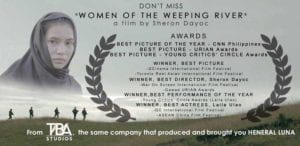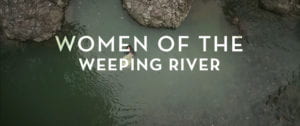2016 | 1h 25min | Written and directed by Sheron Dayoc

“By focusing on the women burdened by fate and tradition, Dayoc creates a prose poem.” — CNN
“Outstanding and superb.” —Young Critics Circle
Two women in a remote Muslim community confront an escalating blood feud and reach deep into themselves in hopes to undo a devastating conflict stretching back generations. Blending realism, memories and dreams, this delicately powerful film tells the story of individuals forced to confront unquestioned perceptions and tragedies, hidden sorrows, and the exhilaration of fresh possibilities.
Cast: Laila Ulao, Sharifa Pearlsia Ali-Dans, Taha Dranda, Dalma Baginda
Production: TBA Studios, Southern Lantern Studios and Haut Lesmains with the support of the QCinema Film Festival, the Asian Cinema Fund, the Hubert Bals Fund, and the Tribeca and Sundance Film Institutes.
Awards:
| Toronto Reel Int’l Asian Film Festival | Best Picture |
| War on Screen Int’l Film Festival | Best Director |
| QCinema Int’l Film Festival | Best Picture, Actress, Supporting Actor |
| Asean-China Int’l Film Festival | Best Actress |
| CNN Philippines | Picture of the Year |
| Young Critics Circle Awards | Best Film, Actress |
| Gawad Urian Awards | Best Picture, Direction, Screenplay, Supporting Actress, Editing, Cinematography |
Note for Techies: Women of the Weeping River was shot in 4K resolution with Sony A7S-II, and Panasonic Varicam LT cameras, with Leica Summicron-C lenses. The production is one of the first films to use the Varicam LT. It was later presented in cinemas at 2.35 aspect ratio.
About the Director
Sheron Dayoc is a director and producer who shifts from fiction and non-fiction storytelling to directing TV commercials. Notable films: Halaw/Ways of the Sea (2010), NETPAC Special Mention Award at the Berlin Int’l Film Festival 2011, APSA NETPAC Development Prize at the Asia Pacific Screen Awards 2011, and Best Film at the Cinemalaya Philippine Independent Film Festival 2010. The Crescent Rising (2015), BIFF Mecenat Award for Best Documentary at the Busan Int’l Film Festival 2016, and Best Documentary at the QCinema Int’l Film Festival 2015 and the Gawad Urian Awards 2016. Women of the Weeping River (2016), Sundance Screenwriters Lab 2011, Asian Cinema Fund 2011, Hubert Bals Fund 2013, Best Picture at the Gawad Urian Awards 2017. CNN Philippines picked the film as one of the top 25 greatest films of the decade. His latest film project, The Sixth Finger, is one of two Philippine film projects invited to the Berlinale Talents Project Market at the 2021 Berlin Int’l Film Festival.
About the Film
 Women of the Weeping River is set in the southern Philippine region of Mindanao. Of the archipelagos’s three major geographical groupings, Mindanao remains the most ethnically, culturally, and religiously diverse. Violent conflicts among its Muslim, Christian, Indigenous and Animist populations have plagued the region from at least recorded times during the Spanish colonial period when native Muslim and Indigenous populations managed to resist or elude the Spanish colonization more successfully than did those in other parts of the country. (Interestingly, the former southern Spanish fort of Zamboanga in Mindanao led to the formation of a province with a dialect called Chabacano that, unlike all others of the Philippines’ 70-plus dialects, could be mistaken for a Spanish regional tongue, however sounding much devolved.)
Women of the Weeping River is set in the southern Philippine region of Mindanao. Of the archipelagos’s three major geographical groupings, Mindanao remains the most ethnically, culturally, and religiously diverse. Violent conflicts among its Muslim, Christian, Indigenous and Animist populations have plagued the region from at least recorded times during the Spanish colonial period when native Muslim and Indigenous populations managed to resist or elude the Spanish colonization more successfully than did those in other parts of the country. (Interestingly, the former southern Spanish fort of Zamboanga in Mindanao led to the formation of a province with a dialect called Chabacano that, unlike all others of the Philippines’ 70-plus dialects, could be mistaken for a Spanish regional tongue, however sounding much devolved.)
A volatile mix of deep-seated mistrust, land rights controversies, questions of fair exploitation of natural resources, neglect from central government, religious extremism, and a deep-rooted feudal warlord system has made the search for a lasting solution intractable. Yet paradoxically, it is this very intractability that has largely preserved the rich natural resources and haunting enigma of the region.
Dayoc was born and raised in Zamboanga, the son of a Protestant military father. Growing up, he became fascinated with the diverse and colorful cultures around him, and his earliest poetic shorts told stories of characters from the Yakan ethnic group. Women of the Weeping River is also set in the Yakan community, a horse-riding Muslim group that believes in ancient spirits. Dayoc wrote the screenplay in English, then had it translated to the Tausug dialect, which was then performed by locals who had never acted before.
Said Dayoc: “Growing up in Mindanao and having a father as a military officer gave me a better understanding of this land and its issues I grew up with. Having produced documentaries on the lives of people on the grassroots level, particularly the marginalized people and different tribes in Mindanao, has allowed me to create factual and culturally-sensitive films on the people of Mindanao.”
The idea of telling a story around the rido, clan conflicts often going back generations, came to Dayoc when the Sundance Institute named him one of the five fellows to the annual Sundance Institute Script Lab in Park City. He received the Sundance invitation from out of the blue on the strength of his first full-length feature film, Halaw/Ways of the Sea which won the NETPAC Special Mention Award at the 2011 Berlin International Film Festival.
In the usual scrappy and resourceful way of Philippine indie filmmakers that have been winning international film festival awards, Women of the Weeping River was shot over a mere two weeks in July 2016, in Zamboanga City and Jolo.
As originally presented at the Sundance Script Lab, the screenplay’s first screenplay was a ghost story entitled Satra, after the name of the main character. The screenplay went through about a dozen drafts, almost each one with a radically different story and character dynamics, as Dayoc searched for the soul of the film. Despite the extreme changes, the film, as it eventually became known under the final title, remained remarkably faithful to the original vision that Dayoc presented in his Director’s Statement at the Sundance Screenwriters Lab:
“Satra is a film with two worlds woven into one fabric with two unique strands, the real human world and the world of the Lutaw (Spirits). Though the two are different, it is crucial in the story that they co-exist and are parallel to each other. The real world is the hope and the long forgotten identity of the spirit world. On the other hand, the spirit world represents the past and the sole witness of the long history of death from the political and social unrest of the Village/Land of Mindanao.”
—Gil Quito
Stream the Movie
In coordination with the film’s co-producer TBA Studios for the Visions/Panawin Film Series, we have ensured that Women of the Weeping River will be available free of charge on TBA’s YouTube Channel from April 9 to 15.